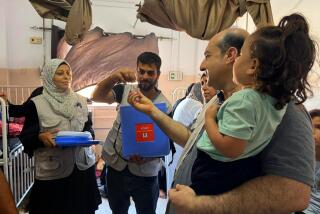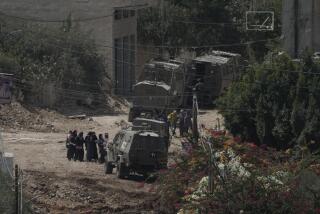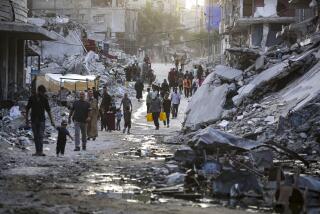Her travels battled polio
Some travels are for pleasure, excursions for amusement, escapes from the familiar. Some are for business. But others are for reasons that go beyond ourselves.
This was one of them. And strangely, it gave me more than any trip has thus far. It had an energy of its own, a humbling earthiness and a soulfulness that transcended its purpose: to vaccinate the children of northeast India against polio.
A recent college grad, I’d been granted a scholarship -- the Rotary Ambassadorial -- that allowed me to participate in the Global Polio Eradication Initiative, a 20-year-old program that is one of the largest public health campaigns in the world.
Polio is a viral infection that can cause paralysis and death and most often affects children. Epidemics were reported throughout the world in the first half of the 20th century, including the United States. By 1962, the disease had been largely eradicated in the Western Hemisphere. But in 2008, 1,651 cases were reported, and 1,505 of those were in the four remaining endemic nations: India, Pakistan, Nigeria and Afghanistan.
In India, the virus lurks in the contaminated waters of Uttar Pradesh and Bihar, so our mission was to vaccinate as many children as possible. Perhaps as important, we were also to rally the local UNICEF and Rotary workers, thanking them for their dedication and hard work.
We landed in Indira Gandhi airport in Delhi dressed in our loud yellow jackets, designed to create awareness about polio. The scenery was familiar to me. I was born in that city. Little did I know that life would be cyclical.
In the ensuing weeks, I found plenty that was not as familiar: peeling polio signs plastered on crumbling buildings; crowds of children around my knees as we tried to vaccinate them; the kindness of strangers in the field; the endless cups of chai accompanied by heated debates between us and the locals on public health; rickety rickshaws with polio banners.
As visiting Rotarians, we were to consult with the community-level polio heads (of the World Health Organization, UNICEF and Rotary) and extract details about the fight against the disease. But it was in the field, meeting with those in villages and slums, where I learned far more.
One of the most challenging (and frustrating) obstacles was that children can be vaccinated but still contract polio. The sewers that run along the dirt roads explain why it’s so hard to fight this water-borne disease: Uncovered, unprotected, filled with filth, they’re a breeding ground for polio and other illnesses, and children who can’t go to school spend their time playing on those dirt roads, kicking a deflated soccer ball, throwing marbles and being themselves, silly, carefree, untroubled by their surroundings.
It’s easy to become overwhelmed and feel burdened by the immensity of the problems, the long list of issues that need to be addressed. In fact, many of my fellow travelers were struck by the incredible inequality.
But each trip back to India for me has unveiled a beauty in the country that is hard to ignore. And it’s not in its palaces and mausoleums; it’s in those same people, the ones we went to serve.
These are the children whose pinkie fingers are not stained black, the sign that they haven’t been vaccinated. And many of them are children without a footprint: not enrolled in schools, not sitting with their parents in a shop or office, not living in one residence for long. Instead, they’re on trains that service northern India, migrating with their parents from one city to another, hidden in the threadbare tents of the slums, on the periphery of towns in dilapidated forgotten neighborhoods. They’re born in the countryside without the aid of a midwife or a hospital and don’t carry birth certificates.
So that blackened pinkie is the only indication that they’ve been vaccinated. Wherever we went, we were in search of that stain.
Although polio vaccination was our primary task, we also ventured into hospitals, blood clinics, schools and religious sites, many of which house Rotary projects. One such place was a local school, really a covered patio area adjoining a Rotarian’s house. Dozens of schoolchildren gathered every afternoon to learn Hindi, their native language. These were the children of rickshaw wallahs and maids, children who were not likely to receive an education. The goal: literacy, plain and simple.
In the motley group of students, crowded on the floor, their knees overlapping one another, one face struck me: She had a simplicity, an elegance, a gentle beauty. Her name matched it: Kavita, meaning “poetry” in Hindi. I smiled at her; her smile widened. I asked her name, her age, how often she came to school, if she liked it. She answered timidly. I asked whether I could get a photo with her. Her smile grew wider. I wove my way through to find a spot next to her.
Sitting amid those pupils, I felt at home; after all, I’m still a student myself.
I noticed a boy, a few feet away, unperturbed by our presence, uninterested in the photo. He was much younger than the rest. He was bent over, almost in a prayer-like position. Instead of hands folded in supplication, his were gripping a book. His dark head of hair moved back and forth as he read, uttering each word, stammering along the way.
The teacher, a young woman about my age, asked him to repeat. He started again, swaying back and forth as he read. His gaze never left those pages. I slipped out while he was still reading. He never saw me.
Images like that have stayed with me. Those are the signs of prosperity, progression, perseverance and a spirit to succeed.
One last image is imprinted on my mind: a UNICEF worker hidden beneath her dark niqab, standing under a doorway adorned with a tattered polio banner, inoculating child after child. Accompanying her were two Rotarians from California, a local Muslim leader who had been our guide that afternoon, and I. In a health campaign that had been hampered by religious and political dissent, this was a novelty.
It reinforced that disease has no color, religion, ethnicity or political affiliation. Regardless of how exotic the people, how foreign the new territory, humanity is simply one force. Travel lets me see that. And service lets me partake in it.
More to Read
Sign up for The Wild
We’ll help you find the best places to hike, bike and run, as well as the perfect silent spots for meditation and yoga.
You may occasionally receive promotional content from the Los Angeles Times.






